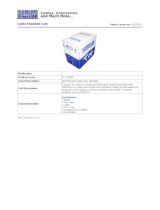
11
FREQUENTLY ASKED QUESTIONS
What kind of CAT-5e cable should I be using?
Solid core CAT-5e cable rated at 350 Mhz and terminated in 568a or 568b is the
minimum requirement. For resolutions greater than 1280x1024 or 1080i, Gefen
recommends solid CAT-6 cables.
I’m getting no video on the screens, what can I check?
First thing to check is make sure that the video CAT5 is linked to the other video CAT5 port
and the same with the DDC ports. Test to make sure the units are working with short CAT-5e
cables 15-20 feet. You can also make sure you have the correct boost setting confi gured
(please refer to page 10).
I’m getting no video on the screens using ADC to DVI adapters, what is wrong?
ADC to DVI adapters remove the necessary 5V line that the extenders require on the input
to operate. To enable the 5V you will need to open up the Sender unit. Next to each DVI
input connector will be a jumper that needs to be shorted to enable 5V to the input. This
should only be enabled when using a ADC to DVI Adapter otherwise damage to your video
card may result.
How can I fi x a fl ickering picture?
Flickering or a blinking image is the result of a loss of sync between the display and
the source. Try lowering the resolution, if this helps, the CAT-5 cables you are using
are unable to handle the bandwidth of the higher resolution and thus you are losing
sync. Try a shielded CAT-6 cable on the video line to reduce interference, which can
be caused by EMI. A shielded CAT-6 with metal RJ-45 connectors with the drain wire
soldered to the connectors will resolve an EMI issue. You can also try adjusting the
service switches. Page 10 contains a guide to setting the service switches.
Why is there a green or pink tint to my picture?
A tint of green or pink in the picture is a result of incorrect colorspace being transmitted.
This can be resolved by recycling power on your devices including the extender. If this
does not help, the DDC data containing the colorspace is not being transmitted correctly
due to loss in the CAT5 cable, try replacing the DDC cable.
Why is the USB dropping out every so often?
Drop outs occur on occasion but if it is happening quite often, then interference along the
DDC line that is also transmitting USB is causing the problem. Try using a shielded CAT-
5e cable on this line instead.
I can’t seem to get my RS-232 devices to detect and connect, what’s wrong?
The CAT5-7500HD system only extends the Tx and Rx lines of RS-232. If you need full
RS-232 extension of every line, you will need the standalone RS-232 Extender units.
Can I run the CAT-5 cable through a patch bay or punchdown block?
No, the signal will not transmit reliably.























